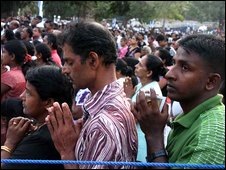 A sudden phone call gave the BBC’s Sri Lanka correspondent Charles Haviland rare access to the the war-battered north of the island. He saw Tamils languishing in a vast refugee camp – but also scenes of ethnic harmony at a Catholic shrine.
A sudden phone call gave the BBC’s Sri Lanka correspondent Charles Haviland rare access to the the war-battered north of the island. He saw Tamils languishing in a vast refugee camp – but also scenes of ethnic harmony at a Catholic shrine.
You do not expect, in northern Sri Lanka, to encounter a red double-decker London bus, but there it was, trundling along in front of us.
The buses were brought over by the British in the 1940s, someone explained. They were still going strong.
We were travelling through the lands on the edge of the old war zone.
Since the defeat of the Tamil Tiger rebels, Sri Lanka is unified again. But this is still a zone of crossing over, into Tamil country, a place still raw from conflict.
Here were Tamil shop names and Hindu temples but at the same time, flags of the Sri Lankan state and its Buddhist majority, and an advertisement for the army.
Incarceration
The message was clear – the government’s writ runs here.
But access to the north remains tightly controlled. My surprise visit sprang from a sudden call from the information ministry.
They were inviting me and other reporters to Sri Lankan Catholics’ most revered shrine, Our Lady of Madhu.
I had been there before, in 2002, when it lay in what was then the Tamil Tigers’ state-within-a-state. The tables were now turned.
A woman was pounding away at grain outside her house.
Then came the vast expanse of Menik Farm, the refugee camp which the Sri Lankan government wishes the world’s media and human rights groups would stop talking about.
About 250,000 Tamils displaced in the war’s final months are now detained there.
The government has said the careful screening of these people is the only way it can guarantee the country’s future security, as they lived among the Tamil Tigers.
However its critics have said it is unacceptable to keep people incarcerated in such a way.
The journalists’ bus did not stop. Beyond the barbed wire, though, we saw youngsters playing cricket, hundreds of tents, and huts with iron roofs.
We saw people queuing, waiting, for what, we did not know.
On the camp fences we saw many huge posters of President Mahinda Rajapaksa, alone, or with his two beloved brothers, both of them also top officials.
After the camp, there were no more villagers to be seen. The north is largely depopulated, most of its people now in camps like Menik Farm. Soldiers stalk this landscape.
Schools have been emptied of their pupils and become barracks. Within minutes, torrents of unseasonal rain had transformed the red-brown soil into streams and mud.
Later the news filtered out that parts of the camp had been inundated.
But ahead of us in the mud were not refugees, but pilgrims.
Pilgrims’ harmony
The forests around the Madhu shrine were filled with mainly Catholic devotees who had come for the Feast of the Assumption.
They had built their shelters in a wonderfully haphazard way, with flapping tarpaulins and brightly-coloured sheets.
Whole lanes of kiosks had sprung up, offering ice cream, ginger beer and Sri Lankan snacks. Families picnicked and prayed. There was an atmosphere of relaxation, of humour, and broadly, of ethnic harmony.
Most of the visitors were Sinhalese people who had not been able to visit during the years of Tamil Tiger control.
"People are mixing," said one, Ambrose Bartholameus. "There are different races and different religions here."
It was slightly different for the Tamils I met. Most had close relatives confined to the refugee camps.
"My sister is in Menik Farm," one youth told us.
"I’ve no idea when she will be able to leave. In three months, perhaps?"
All he and his parents can do is visit her, briefly, every week or so.
Little wonder that most local Tamils lucky enough to live outside the camps just did not feel like coming here to this voluntary settlement.
It was strange, too, to think of this church’s place in Sri Lanka’s changing fortunes. Ten years ago 40 civilians sheltering here were killed in crossfire.
When I first visited, during the 2002 ceasefire, the policemen and women of the Tigers’ fledgling state stood on guard. I talked to one of them, a former fighter who said most of the Sinhalese he had met were dead bodies on the battlefield.
Scrubby jungle
He said suicide bombings were a means of liberation, and that such bombers were "guided" by the Tamil Tigers leader, Prabhakaran, whom he worshipped.
Where was that policeman now, I wondered? Surely dead. Today, the Tiger police had given way to the Sri Lankan state police, edgily on guard in this place of worship.
With so many local Tamils not free to visit, Madhu’s festival this year had a bittersweet feel. The army had accommodated us nearby with great kindness.
We drove back through the scrubby jungle.
"Thank you, come again," said the army sign.
(For updates you can share with your friends, follow TNN on Facebook and Twitter )
